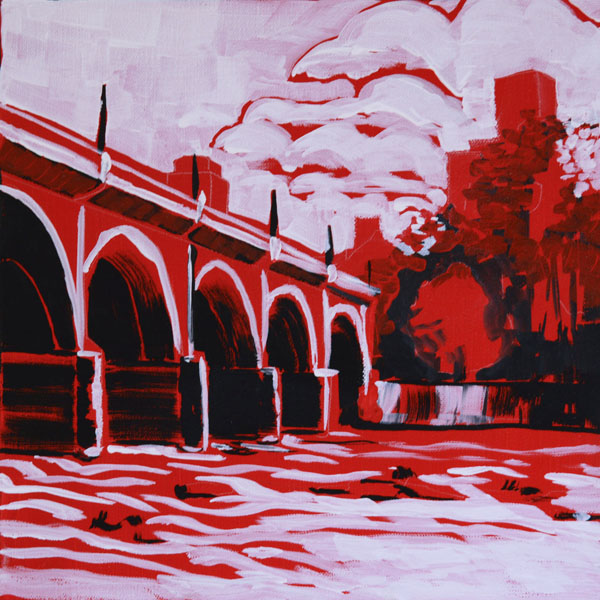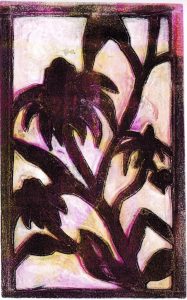
12×12″
Acrylic on gallery wrap canvas
©2015 Lucinda Howe
NFS
What’s Black and White and Red all over? If you think the answer to this riddle is “a newspaper”, you’re showing your age. Do they even publish such a thing any more? If you said it’s a zebra with too much lipstick, you’re thinking like a nine-year-old, but you’re closer. In my world, the answer is a 3-value study for a painting.
Last fall I started a new series of paintings based on the iconic image of the Gervais Street Bridge over the Congaree River between the cities of Columbia and West Columbia, South Carolina. I have painted this bridge many times as have most other artists around Columbia. In fact, it has been painted so often, it has crossed the line from icon to cliché.
I work in a series in order to develop a consistent body of work while allowing myself room to experiment and grow. Although I find myself drawn to familiar subject matter and may accumulate several paintings of the same thing over the course of time in different mediums and styles, they don’t always work together. Working in a series is more intentional and needs to have some common elements to hold the series together.
In this case, I wanted to start a series that focused on Fauvist techniques and local subject matter. My favorite historical and contemporary Fauve artists paint their local landscapes. What ties them together is a common use of bold, subjective color and expressive brush strokes. My first thought is that if I could go to London I could paint like Derain or if I went to Taos I could paint like Alyce Frank, but I know that I don’t have the intimate knowledge of those landscapes that they have. To develop my own style, I must paint my local landscape with my own color sense.
So that brings me back to Columbia. I decided to start with the Gervais Street Bridge and the Riverwalk because it is so familiar. I challenged myself to see it in new ways. I also established some additional parameters to tie the series together. I’m using acrylic paints on gallery wrap canvas in a square format prepared with red gesso. As I started to make studies for the paintings, I found that a good way to make a value sketch was to use black and white gesso for the light and dark values, leaving the red gesso as the middle value. Sometimes I left this as a study and sometimes I used it as an under painting and applied colors on top of it.
As the series developed, I changed the perspective, colors, and style. You will see the changes in the coming weeks. I’m still working on the series and looking for ways to push the boundaries. My next challenge is to figure out when the series is finished.
